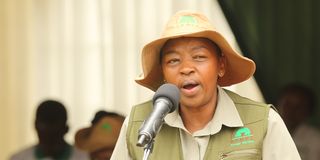Rachel Ruto adopts Kakamega forest in conservation push

First lady Rachel Ruto at the Kakamega forest on November 17 2022. She led residents in a tree planting exercise in celebration of her birthday.
First lady Rachel Ruto has adopted 200 hectares of the Kakamega equatorial forest as part of her programme to conserve the environment and fight the negative impacts of climate change.
The forest measures about 4,486 hectares.
Mrs Ruto, who led the planting of 2,000 tree seedlings in the forest Thursday morning, urged women to plant more trees and be in the forefront in the fight against climate change.
“I am here in Kakamega to adopt part of the forest and plant trees in response to the call by the President that by 2032 each Kenyan should have planted 300 trees. If we all accept this call, we shall have planted 15 billion trees in the next ten years,” she said.
She is collaborating with first ladies from all county governments to boost tree planting across the 47 counties.
“Alongside the women empowerment programme which I have been running in the last five years, we shall work closely with the county first ladies to plant trees and conserve the environment to avert drought that is ravaging parts of our country,” she added.
Mrs Ruto promised to visit all counties with forests to promote tree planting and forest conservation.
She wants women around forest areas to change their means of cooking from the use of firewood and charcoal to clean energy as a way of promoting the campaign.
This comes amid fresh campaigns to install electric fences around the forest by the Kakamega County government in collaboration with other key partners to conclude the project that was launched in 2015 and is aimed at preventing people from encroaching on the forest.
The National Environmental Trust Fund (NetFund), United Nations Development Programme, Kenya Forest Service (KFS), Rhino Ark Kenya and the Kenya Wildlife Service are partnering with the Kakamega and Vihiga county governments to erect the fence.
Kakamega first lady Janet Barasa said the forest provides several crucial ecosystem services, including catchment protection, maintaining the water cycle in the region, habitats for wildlife, mitigating climate change impact, a hub for recreation, research and education, and a source of medicinal plants.
“The famous mukombero, which is rich in medicinal ingredients and a heritage that we need to protect at all costs, is only found in this equatorial forest. Mukombero is famous among our men and they know what it means,” Ms Barasa said.
Many species of animals, birds and trees in the forest are not only endemic but also endangered.
Large number of bird species
Ms Barasa pointed out that the Kakamega forest is designated as an important bird area because it hosts large numbers of bird species.
“Out of the 1,165 bird species found in Kenya, it is confirmed that 472 species are found in Kakamega forest. Unfortunately, the county of Kakamega regrets that [the] forest is highly degraded and faced with various threats that compromises its existence,” she added.
Threats facing habitats in the forest include logging, encroachment, climate change and prolonged dry spells that are reducing the forest’s biodiversity.
Kakamega is promoting the culture of tree growing among its residents in efforts to attain 10 per cent forest tree cover.
Ms Barasa said the county was working closely with the community surrounding the forest to conserve it and that the community supports the fencing of the forest to protect and rehabilitate the rainforest.
She said other forests in Kakamega targeted by the county government are Bunyala, Lugari and Malava.
Environment Cabinet Secretary Soipan Tuya said her ministry will provide seedlings and technical advice to President Ruto’s call to plant 15 billion trees in the next 10 years.
“The target of restoring 10.6 million hectares by planting trees translates to 1,006,000km square of tree cover. This is twice the size of the country’s largest county – Turkana – and 34 times the size of Kakamega County,” she said.
She cited the National Forest Resources Assessment report of 2021 that said national tree cover now stands at 12.13 per cent and the national forest cover stands at 8.83 per cent, up from the previous 5.9 per cent in 2018.
“Achieving the 10.6 million hectares tree cover will triple the set constitutional threshold,” she said.
“Achieving this ambition and inspiring milestones will involve participatory forest management including engagement of the local communities and working hand in hand with county governments, promoting participation of the private sector in reforestation partnerships, streamlining forestry volunteer activities and organizational change.”
She said Kenya has 2.6 million hectares of gazetted forest areas under the management of the Kenya Forest Service, but the agency works with county governments to manage about 1.7 million hectares of community forests outside the gazetted public forests.
The Kakamega forest covers 14,810 hectares, comprising 1,610 hectares of exotic plantations and 13,200 hectares of natural forest with indigenous trees.
Ms Tuya said her ministry will use President Ruto's directive that the Kazi Mtaani programme be transformed into a tree planting and growing initiative to consolidate tree planting initiative into tree growing to ensure that all planted trees are nurtured to maturity.
She urged Kenyans to plant trees at their homes and at schools, churches and government offices.





